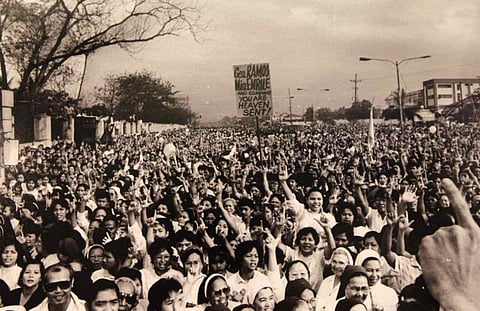Philippines: 10 things to know about the EDSA 'People Power' revolution
It's a historic turning point that sparked a wave of peaceful revolutions worldwide

Manila: For four tense days in 1986, from February 22 to February 25, millions of Filipinos flooded Epifanio delos Santos Avenue (EDSA), culminating a series of popular demonstrations that began in 1983.
The people were unarmed, yet fearless.
They demanded an end to dictatorship. They faced tanks with flowers and prayers, defied tyranny, and toppled Ferdinand Marcos Sr. (the country's 10th president, which until then had been in power for 21 years) without bloodshed.
The EDSA People Power Revolution is a remarkable moment in modern-day history of the world, and became a global symbol of democracy, proving that courage conquers oppression.
These are the 10 things you need to know about the EDSA Revolution:
#1. It happened in 1986
The EDSA Revolution took place from February 22 to 25, 1986, ending the 21-year rule of President Ferdinand Marcos Sr., father of the current president and his namesake, President Ferdinand "Bongbong" Marcos Jr.
#2. A peaceful uprising
Millions of Filipinos gathered along Epifanio de los Santos Avenue (EDSA) in Metro Manila to demand democracy, making it one of history’s most famous non-violent revolutions.
#3. Triggered by election fraud
The revolution followed the fraudulent "snap elections" of February 7, 1986, where Marcos was declared the "winner" against Corazon Aquino, despite widespread allegations of cheating.
#4. The role of the military
Key military figures, including Defence Minister Juan Ponce Enrile and General Fidel Ramos, defected from Marcos Sr government (all of them belonged to the same Ilocano tribe; there are 110 recognised or ethnolinguistic groups in the Philippines). The two rebel leaders and their supporters sought refuge in Camp Crame, calling for public support against the Marcos regime. Millions gathered. Many in the military defected to the rebels' camp who defied Marcos Sr., who by then had been in power for 21 years.
#5. Support from the Catholic Church
Cardinal Jaime Sin, the influential Archbishop of Manila, urged Filipinos to support the uprising through Radio Veritas, leading to massive crowds on EDSA.
#6. Ordinary Filipinos stood up
Civilians, including nuns, priests, students, and workers, formed human barricades, offered food, and even prayed in front of tanks to stop military forces. As choppers hovered above the huge crowd, it was announced that many in the military, led by the Reform the Armed Forces Movement (RAM) and other groups within the uniformed services have also joined the anti-Marcos camp.
#7. Marcos fled to Hawaii
On February 25, 1986, facing mass defections and international pressure (including from the US), Marcos and his family fled to Hawaii, officially ending his regime. Marcos Sr died three years later, on September 28, 1989, while in exile in Hawaii.
#8. Corazon Aquino became president
Cory Aquino, widow of assassinated opposition leader Ninoy Aquino Jr (whose assassination in 1983 triggered protests and economic instability), was sworn in as the first female president of the Philippines on February 25, 1986.
#9. Democracy restored
Besides reinstating democratic institutions, the event significantly raised the bar in order for a Philippine leader to declare Martial Law. The 1987 Philippine Constitution was drafted and approved in a national plebiscite, limiting the presidential term to six years, non-renewable.
More than three-fourths of all votes cast were for ratification. Thus, it was on February 2, 1987 that the 1987 Constitution took effect, ensuring human rights, freedoms and checks and balances.
This ushered in a long road to institutionalising democratic rule.
Reforms included the current Public-Private Partnership (PPP) laws (first legislated in the 1990s), in which private funds bankroll public projects, curbing "crony capitalism" and deregulation (notably of key industries, like telecommunications).
In the last 39 years, GDP per capita of the Philippines went from $426 in 1985 to $4,153 as of end-2024, as per Statista.
#10. It inspired other revolutions
The EDSA event was a pushback against years of abuse of power and hopelessless. In the 1970s and 1980s, historians believe the Marcos dictatorship was marked by 3,257 known extrajudicial killings, 35,000 documented tortures, 737 "disappeared", and 70,000+ incarcerations.
The peaceful success of EDSA became a global symbol of people power, influencing similar movements in countries like South Korea, Indonesia, and Eastern Europe.
It remains a defining moment in Philippine history, reminding Filipinos of their power to fight for freedom and democracy. Now EDSA is emblematic of the worst-in-the-world traffic situation in Manila.
Note: The EDSA Revolution, commemorated every February 25th, has been declared a special working holiday.
As of February 24, 2025, dozens of schools and universities across the country have announced class suspensions for Tuesday, February 25, to commemorate the 39th anniversary of the EDSA Revolt.
Sign up for the Daily Briefing
Get the latest news and updates straight to your inbox



